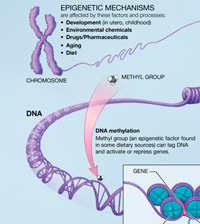Archived Content
The National Institute of Mental Health archives materials that are over 4 years old and no longer being updated. The content on this page is provided for historical reference purposes only and may not reflect current knowledge or information.
Study Probes Environment-Triggered Genetic Changes in Schizophrenia
Life’s Hard Knocks Can Leave Marks That Turn Genes On and Off
• Science Update

The first study of its kind to pinpoint environment-triggered genetic changes in schizophrenia has been launched with $9.8 million in funding from NIMH. The five-site study seeks telltale marks in the genome that hold clues to how nurture interacts with nature to produce the illness.
These "epigenetic" changes that occur with aging and other environmental influences regulate the turning on and off of the genes we inherit, with pivotal consequences for health. Thus, if one identical twin develops schizophrenia, the other twin is similarly affected in only about half of cases, despite the fact that they share the same genes and the illness is estimated to be 80 to 90 percent heritable. Evidence suggests that epigenetic differences may account for the discrepancy.
In the new NIMH-funded study, grantee Andrew Feinberg, M.D., MPH, of Johns Hopkins University, and colleagues at four other universities will compare the epigenomes of people with schizophrenia with those of healthy participants — and with results of conventional genetic studies of the same people.
"Understanding schizophrenia's epigenome can reveal how factors like diet, chemicals, infections and experience impact genetic predisposition," explained Feinberg. "Since epigenetic changes are potentially reversible, our findings may lead to new ways to treat schizophrenia."
Background
What happens to us can't change the sequence of our genetic code, or DNA , but it can affect how it gets expressed. In response to environmental factors, molecules called epigenetic marks attach to DNA in ways that silence or activate genes, resulting in enduring changes in the proteins they express — and sometimes disease. For example, depression-like behaviors that develop in experimentally stressed animals have been traced to such experienced-triggered marks or "molecular scars." Epigenetic mechanisms are also known to be involved in cancer and Rett syndrome.
Feinberg and colleagues have turned up clues to how such epigenetic changes might affect brain development. They recently reported that epigenetic changes ebb and flow over the lifecycle, with members of families often sharing a similar pattern. Such changing gene expression could hold keys to major mysteries of schizophrenia, such as delayed onset in the late teens/early 20s — how a genetically-rooted illness process that likely begins prior to birth spares the brain through childhood, only to erupt in psychotic breakdowns and profound disability at the cusp of productive life.
Plan for This Study
Using newly available technology, Feinberg and colleagues will mount a genome-wide association study of a key type of epigenetic mark created when a molecule called a methyl group attaches to certain parts of DNA (see diagram). Drawing from the NIMH Genetics Repository , they will comb nearly 10,000 sites in the epigenomes of several thousand people with schizophrenia as well as healthy participants for signs of such methylation — and then subject 50 suspect sites to closer scrutiny.
They will also examine illness-implicated areas in nearly 300 postmortem brain samples from affected and unaffected individuals. The epigenetic findings will then be compared with results from conventional genetic studies in the same people in hopes of implicating specific gene activity in the illness.
Participants
In addition to Feinberg, the study will also include research teams led by:
Raquel Gur, M.D., Ph.D., University of Pennsylvania,
Vishwajit Nimgaonkar, M.D., Ph.D., University of Pittsburgh,
Rodney Go, Ph.D., University of Alabama,
David Braff, M.D., University of California San Diego.
Methyl groups attach to DNA in response to environmental factors, creating epigenetic marks that turn genes on or off.
References
Ladd-Acosta C, Pevsner J, Sabunciyan S, Yolken RH, Webster MJ, Dinkins T, Callinan PA, Fan JB, Potash JB, Feinberg AP . DNA methylation signatures within the human brain. Am J Hum Genet. 2007 Dec;81(6):1304-15. Epub 2007 Nov 1. PMID: 17999367
Bjornsson HT, Sigurdsson MI, Fallin MD, Irizarry RA, Aspelund T, Cui H, Yu W, Rongione MA, Ekström TJ, Harris TB, Launer LJ, Eiriksdottir G, Leppert MF, Sapienza C, Gudnason V, Feinberg AP . Intra-individual change over time in DNA methylation with familial clustering. JAMA. 2008 Jun 25;299(24):2877-83. PMID: 18577732
